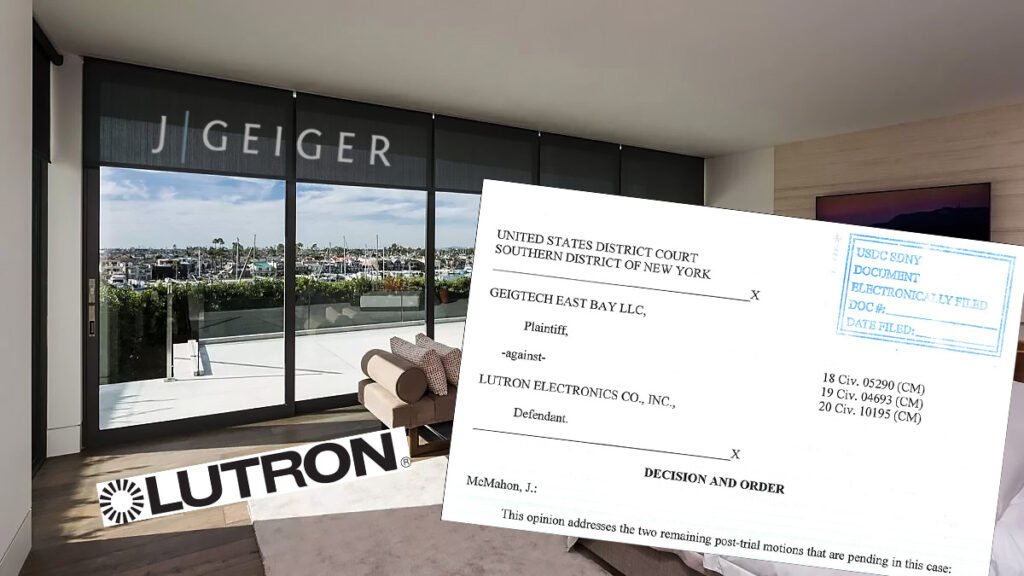
In what has been one of the longest-running patent infringement cases I have ever reported on, GeigTech East Bay LLC vs. Lutron Electronics Co. Inc. finally wrapped up last week in the United States District Court in the Southern District of New York before the Honorable Judge Colleen McMahon who delivered a blistering Final Decision and Order full of fire and brimstone…for both parties. Know that as you read this report, you are reading about a case originally filed on June 12, 2018…that’s right, seven years ago!
Says Judge McMahon: “After two trials and many opinions over the past seven years, the Court assumed familiarity with the facts and major players involved in this case.” And you know what they say about familiarity – familiarity breeds contempt!
See the many surprising facts Judge McMahon’s Decision and Order reveals
GeigTech East Bay LLC is the innovator and manufacturer of a line of motorized shades with unique brackets that feature hidden wires for a more elegant and stylish appearance. GeigTech’s products are marketed under the J. Geiger brand, a separate company owned by Savant Systems, Inc. which was not a party to this litigation. Lutron, of course, is a leading provider of lighting controls, automated shades, and intelligent lighting that is widely supported in the custom integration community.
An Eye-Popping Award Suddenly Went…Poof!
Long-time Strata-gee readers likely recall that I have been following this case closely, especially since GeigTech won the initial trial, in which a jury, upon hearing all of the evidence – much of it highly technical in nature – labeled Lutron a willful and unlawful infringer and awarded GeigTech the eye-popping sum of $34.6 million in damages. Alas, it was to be a short-lived victory, as Lutron would file a motion challenging the size of the award, and the judge would agree that the amount set by the jury was, in her words, “grossly excessive.” Judge McMahon then cut GeigTech’s award to a much more down-to-earth amount of $3.8 million – the amount, by the way, that GeigTech had originally requested in its initial filing.
Now GeigTech – with visions of extra zeros on a monster check dancing in their heads – was upset, and asked the judge to reconsider. McMahon gave GeigTech two options – take the $3.8 million and run…or…schedule another trial to set an amount more in line with the evidence.
GeigTech Requested a New Trial on Damages
I suspect that Judge McMahon was hoping GeigTech would choose the former option – take the money and run. But to her dismay, it chose to have another trial on the damages amount. By the way, Lutron had asked the judge to throw out the whole verdict and order a do-over with an entirely new trial right from the beginning on all issues. The judge quickly denied the Lutron request. However, she reluctantly approved GeigTech’s request for a new trial to set damages.
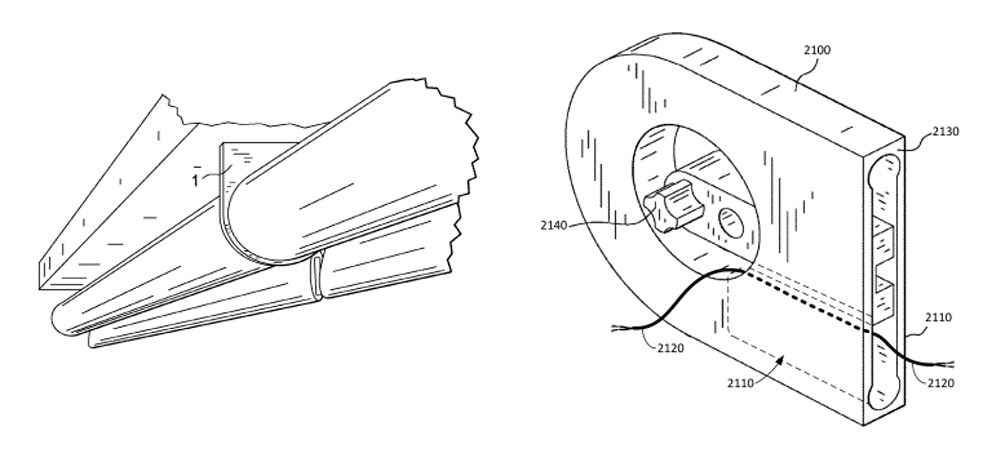
Unfortunately for GeigTech, a new jury had a much different result. Each side was given an opportunity to suggest to the jury what an appropriate award would be. Lutron suggested to the jury that an award of $398,706 was the right number. GeigTech suggested that a fair award would be more along the lines of $4,054,302.
Judge: ‘They [the Jury] Think You’re All Unreasonable’
As the judge noted in her order, “After deliberations [in the new damages trial], the jury followed neither recommendation and returned a verdict awarding GeigTech $2,672,000. What I said at the time remains as true now as it was then: ‘One might say they think you’re all unreasonable, and who am I to quarrel with that.'”
As I noted in my report, GeigTech was likely sorry they opted for a new trial, as it cost them about $1.2 million thanks to a new jury’s finding of a lower award amount.
Only Two Matters Remained to Be Decided
In any event, this final judgment left only two other matters to be disposed of by the judge. First, Lutron had filed a Motion for Judgment as a Matter of Law in which it argued that the jury had inappropriately applied the law to determine the damages award. The second matter for consideration by the judge was the filing of a Motion for Enhanced Damages, Interests, and Costs by GeigTech.
Lutron’s motion was based on the Fed. R. Civ. P. 50(a) [Federal Rules of Civil Procedure 50(a)] motion (known as a rule 50(a) motion) in which it argued that “GeigTech had not met its burden to support a jury verdict that calculated damages via the entire market value rule…” In effect, Lutron was arguing that the jury had used a legal standard to determine the amount of the award – and that legal standard was not properly supported by the evidence at trial supplied by GeigTech. There’s just one problem with this argument – juries are not required to reveal how they calculated their judgment for damages. How did Lutron know the formula the jury used?
Lutron ‘Worked the Math Backwards’ to Figure Out What the Jury was Thinking
Lutron told the judge that they “work[ed] the math backwards”…sort of reverse engineering of the jury’s number…and that answer seemed to annoy the judge. Over nine full pages of analysis, the judge explained the legal standards used to determine reasonable damages awards. I’m not going to recreate all of that here, but I’ll briefly summarize them. There are two legal standards used to set damage awards – the reasonable royalty method and the patentee’s lost profits method. In calculating lost profits, juries can use the Entire Market Value Rule (EMVR) which supposes that the patented technology is such a great innovation that it is the reason purchasers are drawn to the product utilizing that technology. It is, in effect, the entire market for that unique patented capability, which should yield a much larger damages award for the patent holder by basing a royalty on the entire value of the patented product, rather than on just a portion of the product.
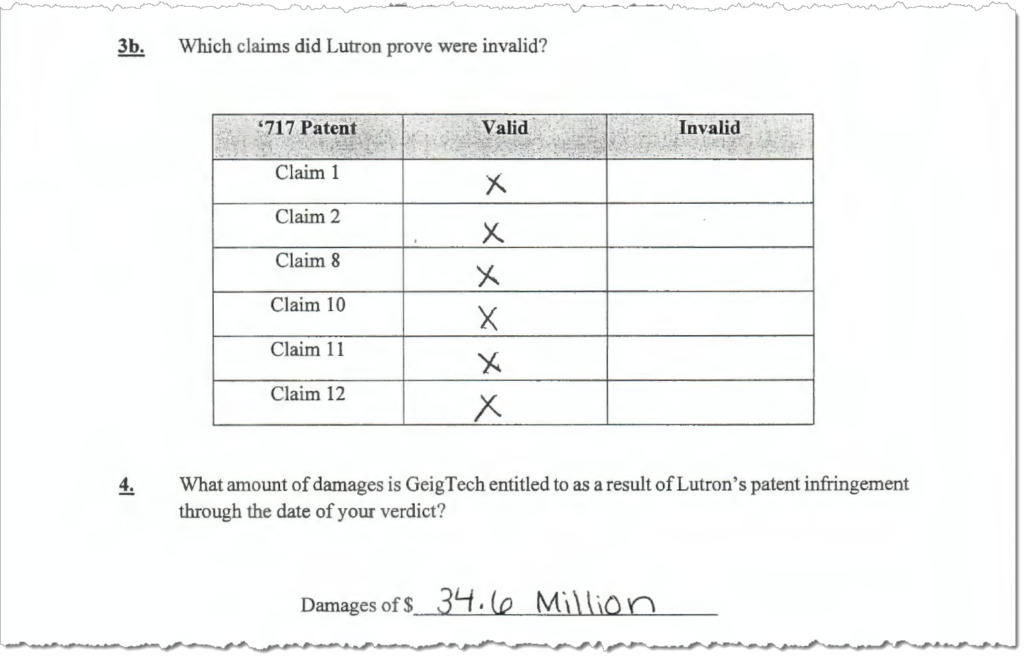
The way legal doctrine refers to this concept was quoted by the judge – “where the patented feature creates the ‘basis for customer demand’ or ‘substantially create[s] the value of the component parts…’ a patentee may base its royalties on the entire value of the patented article…” Even though GeigTech’s filings sought an amount based on a different means for calculation – the “reasonable royalty” rule – that doesn’t mean that the jury must adhere to that form of calculation.
Lutron Motion is Denied
As I mentioned, Lutron told the judge it had determined that the jury used the EMVR by “working the math backwards.” The judge was skeptical of that claim in part due to the fact that the amount Lutron calculated did not exactly match the jury’s award amount. However, in any event, the judge noted that the jury was not precluded from using EMVR if they chose to do so. Not only that, but she said GeigTech offered plenty of evidence to suggest it would be reasonable to use EMVR thanks to GeigTech’s superior bracket design. In fact, Judge McMahon quoted direct testimony from multiple Lutron executives that so much as said so.
Lutron’s Motion was Denied.
GeigTech’s Motion for ‘Enhanced Damages,’ Interests, and Costs
GeigTech asked the judge to award it enhanced damages, as is allowed under the Patent Act. According to the Act, a trial court has the discretion to “increase the damages up to three times the amount found or assessed.” Judge McMahon noted that “Courts may mete out these ‘vindictive or punitive’ damages when ‘the circumstances of the case appear to require it.'” In the case of a “typical” infringement action, such enhancements are not considered necessary.
Rather, they are reserved for use “as a sanction for egregious infringement behavior.” Was Lutron’s infringement “egregious?” In order for a court to impose the maximum treble damages (three times the jury award), “…the court’s assessment of the level of culpability must be high.”
Nine Factors Courts Use to Determine if Enhanced Damages are Appropriate
A previous court case, Read Corp v. Portec, Inc. sets nine factors that a judge must use to determine if an awards enhancement in a patent infringement case is warranted. They are:
- whether the infringer deliberately copied the idea or design of another;
- whether the infringer, when he knew of the other’s patent protection, investigated the scope of the patent and formed a good-faith belief that it was invalid or that it was not infringed;
- the infringer’s behavior as a party to the litigation;
- the defendant’s size and financial condition;
- the closeness of the case;
- the duration of the defendant’s misconduct;
- any remedial action by the defendant;
- the defendant’s motivation for harm; and
- whether the defendant attempted to conceal its misconduct.
Judge McMahon analyzes and deeply discusses each of these factors at length. Again, I will try to summarize the judge’s thinking here. Without a doubt, the most damning factor was factor #1, whether Lutron deliberately copied GeigTech’s idea or design. In her discussion of this factor, we learn of a secret internal Lutron initiative – Project “Snowy Owl” – a plan to obtain and copy GeigTech’s bracket design.
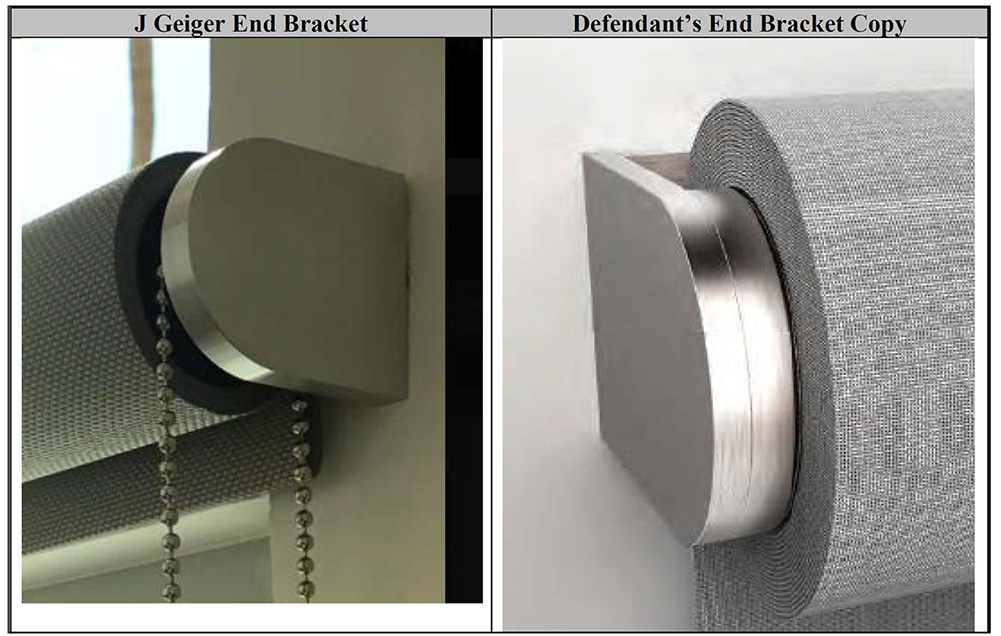
A Summary of the Judge’s Thinking on the Nine Factors of Award Enhancement
FACTOR 1 (Deliberate Copying) From the judge’s analysis…
There is no doubt that Lutron deliberately copied J. Geiger’s ‘717 Patent. In the first trial in this case, the jury found that Lutron’s Palladiom Shading System willfully infringed all of GeigTech’s Asserted Claims. During that trial, Glenn Laverty, a Lutron engineer, and Vladislav Pejic, a Lutron Project Design Leader, admitted to lying in order to gain access to GeigTech’s showroom in New York to investigate GeigTech’s shade brackets. Laverty and Pejic also admitted to having third party homeowners lie on Lutron’s behalf in order to have GeigTech products installed in their homes for Lutron to review. Mr. Pejic and Mr. Laverty’s conduct was part of Project “Snowy Owl”, Lutron’s internal project designed to copy GeigTech’s brackets in order to create what would eventually become the Palladiom Bracket. Evan Graham, Lutron’s manager of engineering, admitted to ‘reverse engineering and modeling . . . from the Geiger patents and literature.’ Dave Kirby, the lead mechanical engineer on Snowy Owl, described the project as ‘look[ing] into designing a system similar to J. Geiger’s brackets for our shades.’ Another engineer on the Snowy Owl team, Max Hakkarainen, stated in his engineering notebook that the purpose of the project was to create ‘Geiger-esque’ shades. [Emphasis added]
GeigTech East Bay LLC v. Lutron Electronics Co. Inc.; Decision and Order
Says Judge McMahon – “This factor weighs in favor of enhancement.”
Here I’ll present a brief summary of the judge’s thinking for each of the remaining nine factors:
FACTOR 2 (Patent Investigation and Good-Faith Belief in Invalidity)
Judge McMahon noted that she had previously ruled that Lutron, while aggressively defending itself throughout the course of this 7-year litigation, had not crossed the line into becoming a “bad faith” actor. She noted, “The fact that both the jury and I clearly did not agree with many of Lutron’s arguments raised in its defense does not mean that those arguments were made in want of a good-faith belief in the invalidity of GeigTech’s patent.”
GeigTech’s argument on this point, the Judge noted, “merely blur this Read factors into others in search of an overarching condemnation of Lutron for willful infringement…” However, the Court’s rules preclude such an approach and insist on a reasoned consideration of “all relevant factors…”
This factor weighs against enhancement.
FACTOR 3 – (Litigation Behavior)
We learn in Judge McMahon’s musings on Factor 3 that multiple Lutron executives and employees lied during their deposition. When I discovered this I braced for a long diatribe from the judge railing against Lutron. In my experience, judges really, really dislike people lying under oath. On the other hand, judges also don’t like parties playing games with the process. And so in one quick sentence, the judge disposed of this factor, essentially deeming it a push.
“…Lutron’s deponent’s lying during a deposition is a serious offense, and is not taken lightly by this Court, so too is the type of gamesmanship that GeigTech engaged in in the leadup to our damages trial. In light of all of the facts underlying the parties’ litigation conduct during this case, I find that…”
“…this factor is neutral on the issue of enhancement.”
FACTOR 4 (Size and Financial Condition)
Read suggests that the size and financial condition of a defendant is an important consideration in determining if enhancement is warranted. We learn here that Lutron is a large, profitable company. Court documents establish that Lutron’s annual revenue is “in excess of $500,000,000” – a number they don’t dispute – and that it generates profits of “at least $25,873,830 on the accused products alone” – a number also not disputed by Lutron.
Lutron, in perhaps a bit of wishful thinking, told the judge just because “an infringer could afford to pay an additional million dollars or so in damages does not provide a reason to do so.” Judge McMahon says that “Lutron is incorrect,” because “[the verdict] may not be enough, without enhancement, to deter infringing conduct.” That’s right, the amount of damages may need to be adjusted to add a deterrent factor against future bad actions by Lutron.
This factor weighs in favor of enhanced damages.
FACTOR 5 (The Closeness of the Case)
This was a close case. Clearly, GeigTech was badass to slap its much bigger, more powerful, and better-resourced rival in a court challenge that would devolve into an intense and costly 7-year bloody war. But, as Judge McMahon noted, “Lutron ‘vigorously pursued’ its case” with defenses that “were ‘meritorious and not exceptional.'” Lutron’s vigorous defense resulted in GeigTech abandoning “two patents-in-suit,” dropping “numerous claims of the ‘717 Patent, failing to obtain a preliminary injunction, losing on other claims of the ‘717 patent, and losing a motion for summary judgment of non-infringement. Lutron was a tough warrior and pretty much a badass as well.
This factor weighs against enhancement.
FACTORS 6 & 7 (Duration of Misconduct and Remedial Action)
The judge lumped these two factors together, as they are clearly related. But in her assessment, she struggles with elements that weigh either way. For example, GeigTech argues that she should weigh towards enhancement because Lutron’s infringement began back in 2016 “and continues to this day.” Lutron asks her to consider its “good-faith” defenses during the entirety of litigation and that it “remediated soon after the jury verdict.”
Here we learn that GeigTech didn’t even apply for the ‘717 patent until May 31, 2018 – “two weeks before this case was filed” – a factor that “should weigh against enhancement,” Judge McMahon notes. On the other hand, many other patent cases have held that “continuing to sell the infringing products after notice of infringement and during the course of litigation” tends to support enhancement.
Judge McMahon’s bottom line? “On these facts, I find that…
…Factors 6 & 7, considered together, weigh slightly in favor of enhancement.
FACTOR 8 (Motivation for Harm)
According to precedent, “When the infringer is a direct competitor, this factor generally weighs in favor of enhanced damages.” This one was relatively clear for the judge who found the parties are “undoubtedly direct competitors.” This is obvious, she says, because “Lutron was motivated to create a bracket that would recover market share that it was losing to GeigTech on account of its novel bracket design.”
This factor, Judge McMahon says, favors enhancement.
FACTOR 9 (Concealment of Misconduct)
Lutron was a pretty clear and open infringer with their Palladiom series, which clearly copied GeigTech’s design. On this, both sides agree. However, GeigTech suggested that the Judge should consider Lutron’s efforts to “‘cover up’ Snowy Owl'” for enhancement – a concept she ultimately rejected.
This factor weighs against enhancement.
The Final Tally
So what did all of this add up to?
Weighs for enhancement – Factors 1, 4, 6, 7, and 8
Weighs against enhancement – Factors 2, 5, and 9
Weighs Neutral on enhancement – Factor 3
Yes baseball fans, with a final score of 5 | 3 | and 1… for enhancement wins the game. However, it wasn’t a dominating win, so the judge did not go for treble damages – choosing instead to double the jury award to a sweet $5,344,000 payday for GeigTech. The judge also granted GeigTech’s motion for pre-judgment and post-judgment interest. Finally, Judge McMahon awarded reimbursement for GeigTech costs associated with this case, to be set at an amount in the future when the company has tallied all of its costs for the judge to review.
GeigTech has ten days to provide that listing of costs to the judge. I have no doubt that GeigTech accountants’ fingers are flying across their computer keyboards right now.
Judge McMahon’s Order
Below is a copy of the District Judge Coleen McMahon’s actual order:
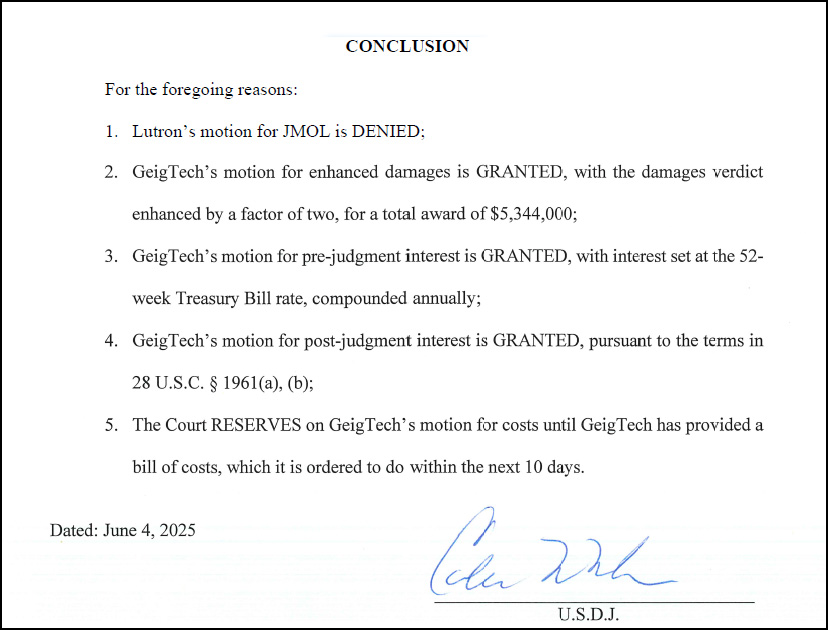
This Matter is Concluded…Maybe
So barring any appeals by the parties, this matter is concluded. The final grand total of the award will depend on the full listing of incurred costs that GeigTech is preparing for the judge, as well as a calculation of the total interest charges, which were awarded for both pre- and post-judgment periods. Given the protracted period of time for this matter, interest charges could be significant. Nonetheless, GeigTech has to feel some measure of vindication in having defended its patents against fierce opposition by a much larger competitor.
However, these seven years of fighting likely took a toll on both parties – and not just in terms of legal fees. In large cases of this nature, sometimes the greatest cost is the distraction of company leaders who end up having to devote an inordinate amount of their time away from critical business issues for participation in legal matters. Things such as preparing documents and other evidence demands; researching, collecting, and responding to opposition documents and evidence demands; reviewing boxes on top of boxes of data production; preparing and performing depositions; attending opposition depositions; answering interrogatories; researching your case; researching your opponent’s case; meeting with attorneys to discuss evolving strategy; and much more.
Perhaps the greatest relief for them both is that all is now behind them and they can all get back to running their businesses.
Unless…there is an appeal.
For More Information…
Learn more about GeigTech East Bay by visiting J. Geiger Shading at jgeigershading.com.
See more on Lutron at lutron.com.





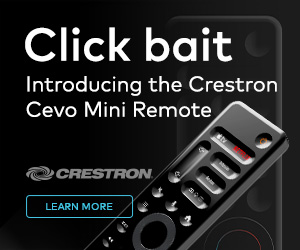
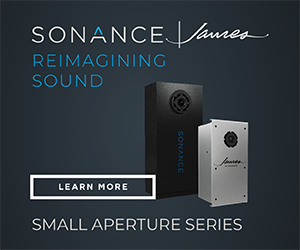



Leave a Reply